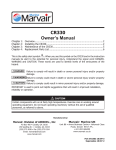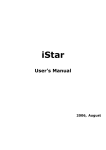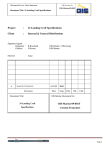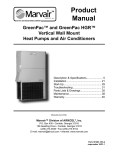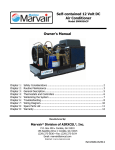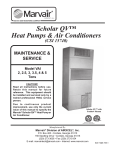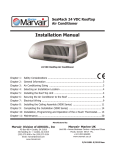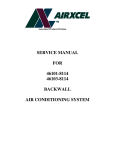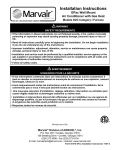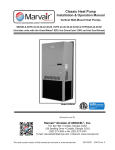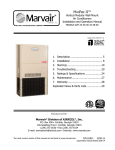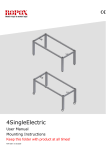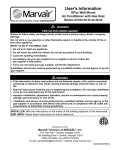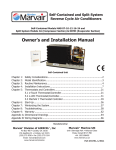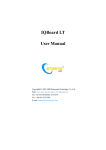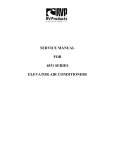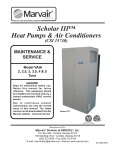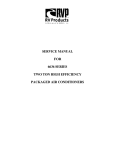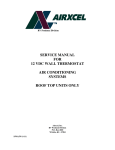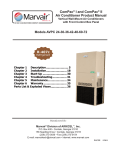Download User manual SeaVent manual
Transcript
SeaVent™ Energy Recovery Ventilator Model FAV0400NCX000H How to Use This Manual & Important Safety Precautions.......................... 2 Chapter 1: Description & Specifications.................................................. 3 Chapter 2: Installation ........................................................................ 7 Chapter 3: Start-Up ............................................................................ 9 Chapter 4: Maintenance....................................................................... 9 Chapter 5: Spare Parts .......................................................................10 Chapter 6: Warranty ..........................................................................10 Manufactured By: Marvair® Division of AIRXCEL®, Inc. P.O. Box 400 • Cordele, GA 31010 156 Seedling Drive • Cordele, GA 31015 (229) 273-3636 • Fax: (229) 273-5154 Email: [email protected] Internet: www.marvair.com Patent Pending Part #01630 09/28/08-1 SeaVent™ Energy Recovery Ventilator How To Use This Manual This manual is intended to be a guide to the installation of the Marvair® SeaVent™ Energy Recovery Ventilator. It covers installation, operation, maintenance and the warranty. The information in this manual is to be used as a guideline only. This manual does not supersede or circumvent any applicable national or local code requirements. If you are installing the SeaVent™ Energy Recovery Ventilator, first read Chapter 1 before beginning the installation. This Chapter contains general descriptive information and provides an overview of the SeaVent™ Energy Recovery Ventilator which can facilitate the installation. If a malfunction occurs, follow the procedure detailed below: 1. Make sure you understand how the SeaVent™ Energy Recovery Ventilator works. 2. Identify and correct installation errors. If you are still unable to correct the problem, contact the factory at + 229-273-3636 for assistance. Please read the following “Important Safety Precautions” before beginning any work. Important Safety Instructions 1. Use care when lifting or transporting the unit. 2. Turn Electrical Power OFF at the breaker or the fuse box BEFORE installing or working on the unit. LINE VOLTAGES ARE HAZARDOUS OR LETHAL. 3. Observe and comply with all applicable electrical and codes and ordinances. 4. Service should be performed only by qualified and experienced people. 5. Beware of sharp edges on sheet metal surfaces. 6. Use Common Sense - Be safety Conscious. This is the safety alert symbol . When you see this symbol on the SeaVent™ Energy Recovery Ventilator and in the instruction manuals be alert to the potential for personal injury. Understand the signal word DANGER, WARNING and CAUTION. These words are used to identify levels of the seriousness of the hazard. DANGER Failure to comply will result in death or severe personal injury and/or property damage. WARNING Failure to comply could result in death or severe personal injury and/or property damage. CAUTION Failure to comply could result in minor personal injury and/or property damage. IMPORTANT is used to point out helpful suggestions that will result in improved installation, reliability or operation. Marvair reserves the right to change, at any time, specifications and designs without notice or obligation. Copyright 2008 Marvair® division of Airxcel®, Inc. SeaVent Manual 09/08 Page 2 of 11 SeaVent™ Energy Recovery Ventilator • WARNING If the information in these instructions are not followed exactly, a fire may result causing property damage, personal injury or loss of life. • Read all instructions carefully prior to beginning the installation. Do not begin installation if you do not understand any of the instructions. • Improper installation, adjustment, alteration, service or maintenance can cause property damage, personal injury or loss of life. • Installation and service must be performed by a qualified installer or service agency in accordance with these instructions and in compliance with all codes and requirements of authorities having jurisdiction. INSTALLER: Leave this manual with the equipment owner. END USER: Retain these instructions for future reference. Chapter 1 – Description & Specifications 1.1 General Description The SeaVent™ Energy Recovery Ventilator (ERV) is designed to be used in vessels where fresh air ventilation is desired or required by codes or statues. It exchanges the energy contained in the air that is exhausted from the boat and uses it to treat the incoming outdoor ventilation air. The SeaVent ERV is a total energy recovery ventilator. During the summer, it removes both humidity and heat from the outdoor air before the air is introduced into the boat. During the winter, it recovers heat from the exhaust air and transfers it to the incoming, fresh air. This reduces the cooling requirement in the boat during the summer and the heating requirement in the winter. 1.2 How it Works The SeaMach ERV consists of the total energy recovery wheel and drive motor, two air movers, two fan speed controllers, and two filters. Incoming and outgoing air streams pass through different sides of the ERV (but are not mixed), allowing conditioned exhaust air to raise or lower the temperature of incoming fresh air. Unlike other units, the SeaMach ERV also allows the exchange of moisture to control humidity. This can be especially valuable in situations where problems may be created by extreme differences in indoor and outdoor moisture levels. In humid summer conditions, it can be critical to dry out incoming air so that mildew and mold do not develop in ductwork. In cold weather, better air flow and additional humidity inside can help control window condensation. After passing through the wheel, the warmed or cooled fresh air typically goes through a chilled water coil or may be sent directly to various rooms. Stale air from return ducts warms or cools the incoming air, depending on the season, before being exhausted outdoors. During hot humid conditions, the SeaVent ERV can remove up to 1-1/2 tons of heat from the fresh air. During cold temperatures, up to 2 tons of heat can be recovered from the interior air before it is exhausted to the outside. This allows the chiller system and heating system on the boat to be reduced in size accordingly and may also permit the use of a smaller generator. SeaVent Manual 09/08 Page 3 of 11 SeaVent™ Energy Recovery Ventilator Conventional fan and vent units significantly increase energy losses by exhausting the conditioned air outside. Odors and pollutants can be removed, but the energy used to condition the fresh air is significant. With efficiencies of up to 75%, the SeaVent ERV exhausts noxious indoor gases and odors with a minimal impact on the HVAC requirements. Each air mover is controlled by a fan speed controller. This allows the air movers to operate a different speeds and the boat to be positively pressurized. The SeaVent ERV is typically used in conjunction with a chilled water coil, but can be used as a stand alone device. When used with a chilled water coil, the SeaVent ERV preconditions the fresh air before the air passes through the coil. This system provides the optimal solution for fresh air make up and is the recommended installation. Figure 1. Ducting & Air Flow Schematic SeaVent Manual 09/08 Page 4 of 11 SeaVent™ Energy Recovery Ventilator 1.3 Model Identification FAV 04 00 NC • 000 H Ventilation Option H = GreenWheel Electric Heat 000 = None Electrical Characteristics F = 220/1/50 A = 208-230/1/60 No Cooling Cooling Capacity None Air Flow 04 = 450 CFM Fresh Air Ventilator 1.4 Serial Number and Date Code A = January B = February C = March D = April E = May F = June G = July H = August J = September K = October L = November M = December U = 2007 W = 2009 V = 2008 X = 2010 1.5 Ratings and Specifications Electrical: 208/230v. 1ø, 60 Hz. or 220-240v. 1ø, 50 Hz. Full Load Amps: 2.2 Minimum Circuit Ampacity: 3.0 Dimensions: 36 cm (14”) x 121cm (47-3/4”) x 60cm (23-3/4”) Weight: 45.5kg (100 lbs) Minimum Outdoor Operating Temperature: -6.7°C (20°F) Components: Two .17 HP Air Movers Marvair Greenwheel® Energy Recovery Wheel Drive Motor: 1/100 HP Cabinet Material: Corrosion resistant white aluminum. SeaVent Manual 09/08 Page 5 of 11 SeaVent™ Energy Recovery Ventilator 1.6 Electrical Schematic Figure 2. Electrical Schematic SeaVent Manual 09/08 Page 6 of 11 SeaVent™ Energy Recovery Ventilator Chapter 2 - Installation WARNING Failure to observe and follow Warnings and Cautions and these instructions could result in death, bodily injury or property damage. Read this manual and follow its instructions and adhere to all Cautions and Warnings in this manual and on the SeaVent ERV. 2.1 Equipment Inspection 2.1.1 Concealed Damage Inspect all cartons and packages upon receipt for damage to the unit and any accessories. Remove the cartons or packaging material and check for concealed damage. Remove the access panels and examine component parts. If damage is apparent, immediately file a freight claim. 2.2 Installation Requirements 2.2.1 Location You must consider all of the following when selecting the location of the SeaVent ERV. 1. Duct work will be connected to the unit at 4 locations – at each end and on the two sides. Make certain that access to these opening is unimpeded. 2. The unit can be installed in either horizontal plane or vertically. 3. There are two filters on the SeaVent ERV. The fresh air filter is a washable mesh type filter that is designed to prevent water from entering the unit. The second is an activated charcoal type filter on the exhaust air stream before it passes through the wheel. These filters must be cleaned periodically so access to the filters is required. 4. The energy recovery wheel inside the SeaVent unit may occasionally require cleaning. Make certain that the exterior panels can be removed to allow access to the wheel. 2.2.2 Airflow Requirements Keep ducts as short as possible. Note that the internal air movers are designed to move the air through the SeaVent ERV. Additional air movers external to the unit will be required to move air through ductwork on the vessel. Duct work should be designed and installed in accordance with all applicable safety codes and standards. Marvair® strongly recommends referring to the current edition of the National Fire Protection Association Standards 90A and 90B before designing and installing duct work. If heaters are used in the duct system, the duct system must be engineered to insure sufficient air flow through the unit to prevent over-heating of the heater element. This includes proper supply duct sizing, sufficient quantity of supply registers, and adequate return and filter areas. Duct work must be of correct material and must be properly insulated. Duct work must be firmly attached, secured, and sealed to prevent air leakage. See section 2.4.2 for additional duct work requirements. SeaVent Manual 09/08 Page 7 of 11 SeaVent™ Energy Recovery Ventilator 2.2.3 Electrical Supply The power supply must have the appropriate voltage, phase and frequency for the model being installed. Voltage must be maintained above the minimum specified values shown below. Refer to the data label on the SeaVent ERV for ampacity requirements. Electrical Rating Specifications* A F Nominal Voltage 208-230 220-240 Phase 1 1 Frequency 60 Hz 50 Hz Letters refer to model number electrical designators. See page 5. Table 1. Electrical Rating Specifications 2.3 Mounting the Unit Before beginning the installation: 1. Inspect the unit for any missing components or parts, e.g. hardware. 2. .Remove access panels and check for loose wires. Tighten screw connections. 3. Complete and mail in the warranty registration card. WARNING Failure to observe and follow Warnings and Cautions and these instructions could result in death, bodily injury or property damage. Read this manual and follow its instructions and adhere to all Cautions and Warnings in this manual and on the SeaVent ERV. 2.4 Duct Connections 2.4.1 General Information The following instructions are for general guidance only. Due to the wide variety of installation possibilities, specific instructions will not be given. When in doubt, follow standard and accepted installation practices or contact Marvair for additional assistance. 2.4.2 Minimum Airflow Requirements The air movers in the SeaVent ERV are designed to move air through the filters and through the wheel. They are NOT designed to move air through extensive duct work, registers or grilles. The duct system must be engineered to assure sufficient air flow through the system, even under adverse conditions such as dirty filters. In some installations, if the length of duct is short and not restricted, an additional air mover may not be required. The recommended application is to use the SeaVent ERV in conjunction with a chilled water fan coil unit to precondition the air. In some applications, a heater is placed in front of the coil for operation in cold weather. Applications using heat should be designed and installed in accordance with all applicable safety codes and standards. Marvair strongly recommends referring to the current edition of the National Fire Protection Association Standards 90A and 90B before designing and installing duct work. The duct system must be engineered to insure sufficient air flow through the unit to prevent over-heating of the heater element. This includes proper supply duct sizing, sufficient quantity of supply registers, adequate return and filter area. Ductwork must be firmly attached, secured and sealed to prevent air leakage. Ductwork must be of correct material and must be properly insulated. ® SeaVent Manual 09/08 Page 8 of 11 SeaVent™ Energy Recovery Ventilator WARNING - FIRE HAZARD All fan coil units with electric heat must have 2.5 cm (one inch) clearance on all four sides of the supply outlet and return air duct that connects to the unit. The 2.5 cm (one inch) clearance must extend on all sides of the supply duct for the first one meter (three feet) from the unit. 2.4.3 Air Flow Adjustment Industry standards require that the quantity of fresh air introduced into the boat is 10% more than the air discharged from the boat. This creates positive pressurization and keeps the odours from the galley and heads from migrating into other areas of the boat. Each air mover in the SeaVent ERV has a speed controller. The speed controllers are set at the factory for positive pressurization. However, once the unit is installed, the air flow in the complete intake and exhaust air system must be checked and adjusted as required. 2.5 Electrical Connections All electrical work must meet the requirements of local codes and ordinances. Work should only be done by qualified persons. The power supply should have the proper voltage, phase and ampacity for the selected model. Refer to the data label on the SeaVent ERV. 1. Size the incoming power supply lines according to Code requirements. Run the power conductors through the knockouts on the electrical control box. Use appropriate conduit and strain reliefs. 2. Connect the wires to the input side of the terminal block. 3. Install the ground wire on the ground lug. There is no controller or ON/OFF switch on the SeaVent ERV - the air movers and wheel will operate whenever power is applied to the terminal strip. To operate the SeaVent ERV in conjunction with the system’s air movers, appropriate control relays or contactors must be field installed. Chapter 3 - Start-Up 1. Apply power to the SeaVent ERV. Verify that the wheel is turning and that both blowers are operating. 2. Make certain that both filters are in place. 3. Verify proper air flow. 4. Inspect all duct connections for leakage. Repair or replace as required. Chapter 4 - Maintenance Marvair strongly recommends that the SeaVent ERV be serviced a minimum of twice a year. At this time, the filters should be inspected, cleaned or replaces as required. The wheel should also be inspected. If the wheel is dirty, it may be cleaned with water or with a vacuum cleaner. Oiling of the fan motors is not recommended. SeaVent Manual 09/08 Page 9 of 11 SeaVent™ Energy Recovery Ventilator Chapter 5 - Spare Parts Description Outside Air mover Capacitor, Outside Air Mover ( 4 ufd 370v) Exhaust Air mover Capacitor, Outside Air Mover ( 4 ufd 370v) Air mover speed controller Energy Recovery Wheel Drive motor, Energy Recovery Wheel Capacitor, Drive motor (2 ufd / 370v.) Pulley, drive motor Drive belt Brush, nylon in plastic holder (33-1/8” long) Brush, nylon in plastic holder (10” long) Brush, nylon in plastic holder (3” long) Filter Model Number 50780 50256 40015 50256 70049 01226 40007 50326 80495 P/80390 90197 (two) 90198 Four) 90199 (two) 91194 Chapter 6 - Warranty Parts If any part of your Marvair SeaVent Energy Recovery Ventilator fails because of a manufacturing defect within twenty-four months from the date of purchase of a new boat or within twenty-four months from the date of installation of the SeaVent Energy Recovery Ventilator, but not to exceed thirty-six from the date of manufacture by Marvair, Marvair will furnish without charge, EXW Cordele, Georgia, the required replacement part. Labor If any part of your Marvair SeaVent Energy Recovery Ventilator fails because of a manufacturing defect within twenty-four months from the date of purchase of a new boat or within twenty-four months from the date of installation of the air conditioner, but not to exceed thirty-six from the date of manufacture by Marvair, Marvair will pay for the related service labor to replace the failed part according to the Marvair Flat Rate Schedule currently in effect. The owner must provide proof of the date of the purchase of the boat or date of installation of the SeaVent Energy Recovery Ventilator. The owner’s registration card filed with Marvair, the invoice for the purchase of the vessel, an invoice for the installation of the SeaVent Energy Recovery Ventilator, or similar documents are examples of proof of the date. When service is required, it must be performed during normal working hours (8:00 a.m. to 5:00 p.m.) Monday through Friday and must be performed by Marvair personnel or their designated Service Representative. The responsibility of the Owner of the Equipment includes the following: 1. To operate the equipment according to the manufacturer's instructions. 2. To provide easy accessibility for service. 3. To check and reset circuit breaker(s) and disconnect before calling for service. (Circuit breaker(s) may be in the main service panel.) 4. To keep the unit clean and free of dirt. SeaVent Manual 09/08 Page 10 of 11 SeaVent™ Energy Recovery Ventilator 5. To clean and/or replace the filters and the wheel as required. 6. To pay the charges incurred when any of the above have not been done. 7. To pay for repair or replacement of any material or part other than those within the Marvair unit or thermostat itself. The owner of the product may ship the allegedly defective or malfunctioning product or part to Marvair, at such owner’s expense, and Marvair will diagnose the defect and, if the defect is covered under this warranty, Marvair will honor its warranty and furnish the required replacement part. All costs for shipment and risk of loss during shipment of the product or part to Marvair and back to the owner shall be the responsibility and liability of the owner. Upon request by an owner, Marvair may arrange for remote diagnosis and repair of the allegedly defective or malfunctioning product or part. An owner requesting performance under this Warranty shall provide reasonable access to the allegedly defective or malfunctioning product to Marvair and its authorized agents and employees. This warranty does not cover damage caused by improper installation; misuse of equipment; negligent servicing; damage due to use of the product for purposes other than those for which it was designed; damage caused by natural disasters, power surges, lightning and submersion; damage caused by unauthorized modifications; and damage caused by improper wiring or power supply to the SeaVent Energy Recovery Ventilator including operating the unit with an undersized generator. THIS WARRANTY AND SERVICE POLICY CONSTITUTE THE EXCLUSIVE REMEDY OF ANY PURCHASER OF A MARVAIR SEAVENT ENERGY RECOVERY VENTILATOR AND IS IN LIEU OF ALL OTHER WARRANTIES, EXPRESSED OR IMPLIED, INCLUDING, WITHOUT LIMITATION, ANY IMPLIED WARRANTY OF MERCHANTABILITY OR FITNESS FOR USE, TO THE FULLEST EXTENT PERMITTED BY LAW. IN NO EVENT SHALL ANY IMPLIED WARRANTY OF MERCHANTABILITY OR FITNESS FOR USE EXCEED THE TERMS OF THE APPLICABLE WARRANTY STATED ABOVE AND MARVAIR SHALL HAVE NO OTHER OBLIGATION OR LIABILITY. IN NO EVENT SHALL MARVAIR BE LIABLE FOR INCIDENTAL OR CONSEQUENTIAL DAMAGES OR MONETARY DAMAGES. THIS WARRANTY GIVES YOU SPECIFIC LEGAL RIGHTS, AND YOU MAY ALSO HAVE OTHER RIGHTS WHICH VARY FROM STATE-TO-STATE. Some states do not allow limitations or exclusions, so the above limitations and exclusions may not apply to you. SeaVent Manual 09/08 Page 11 of 11











